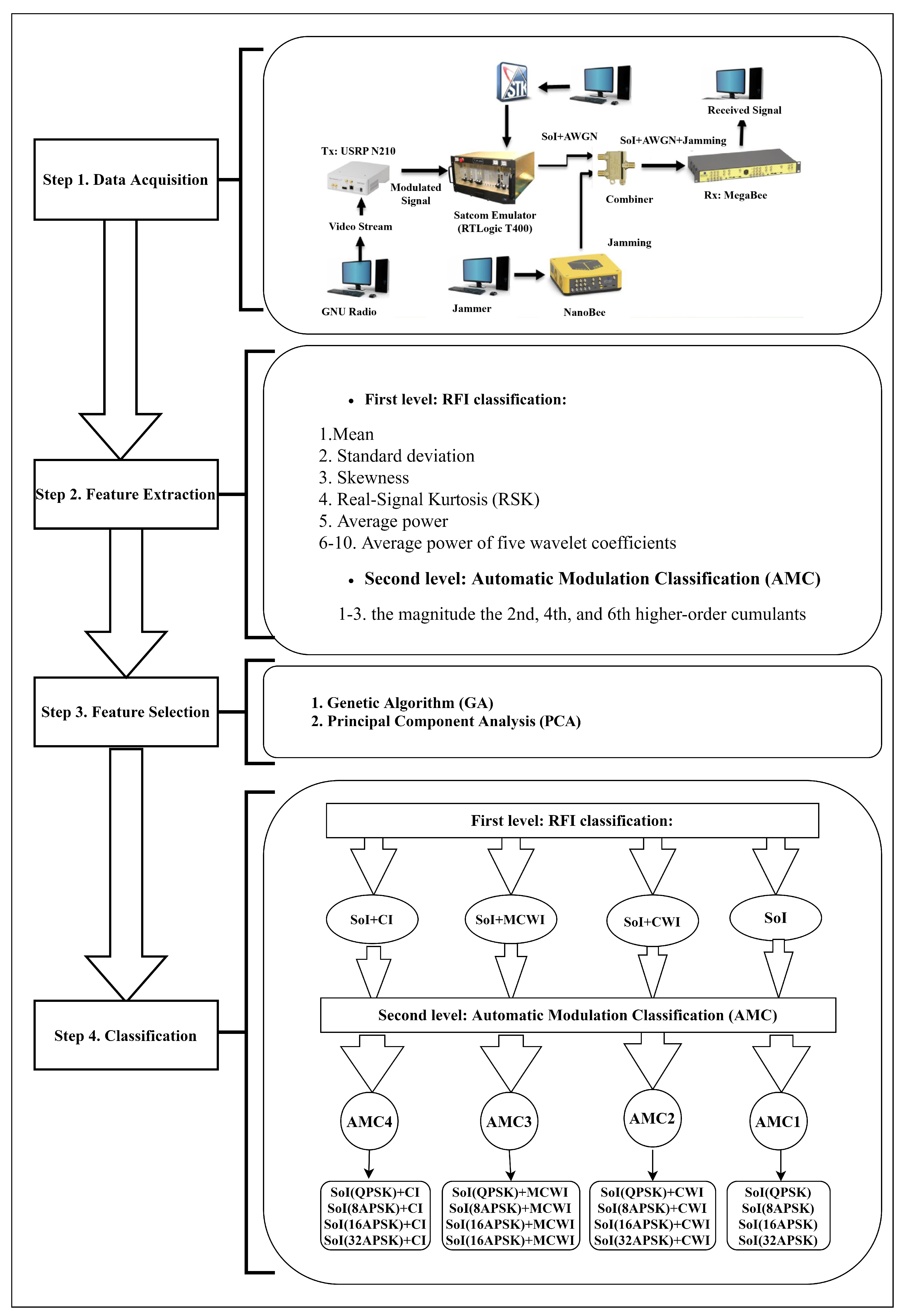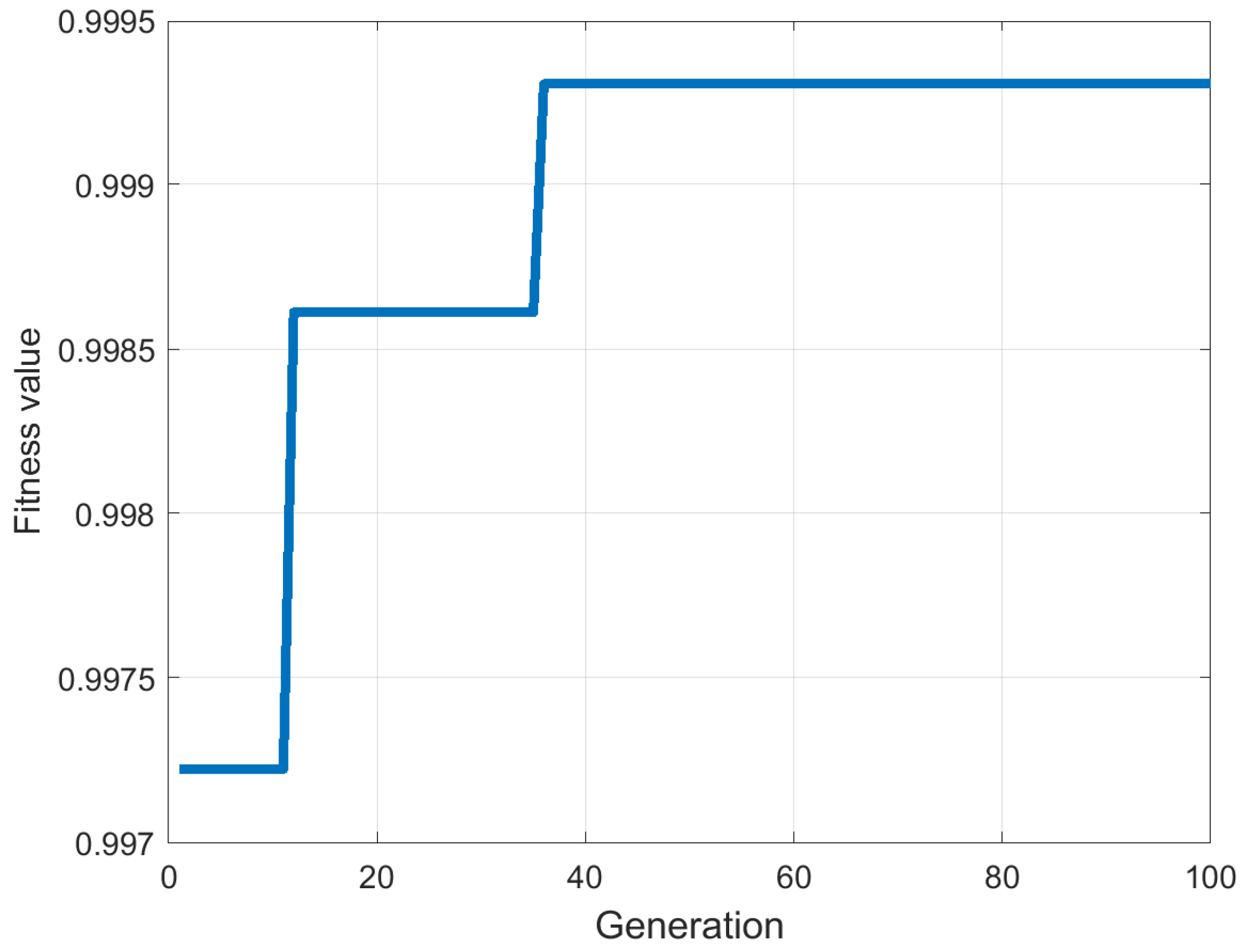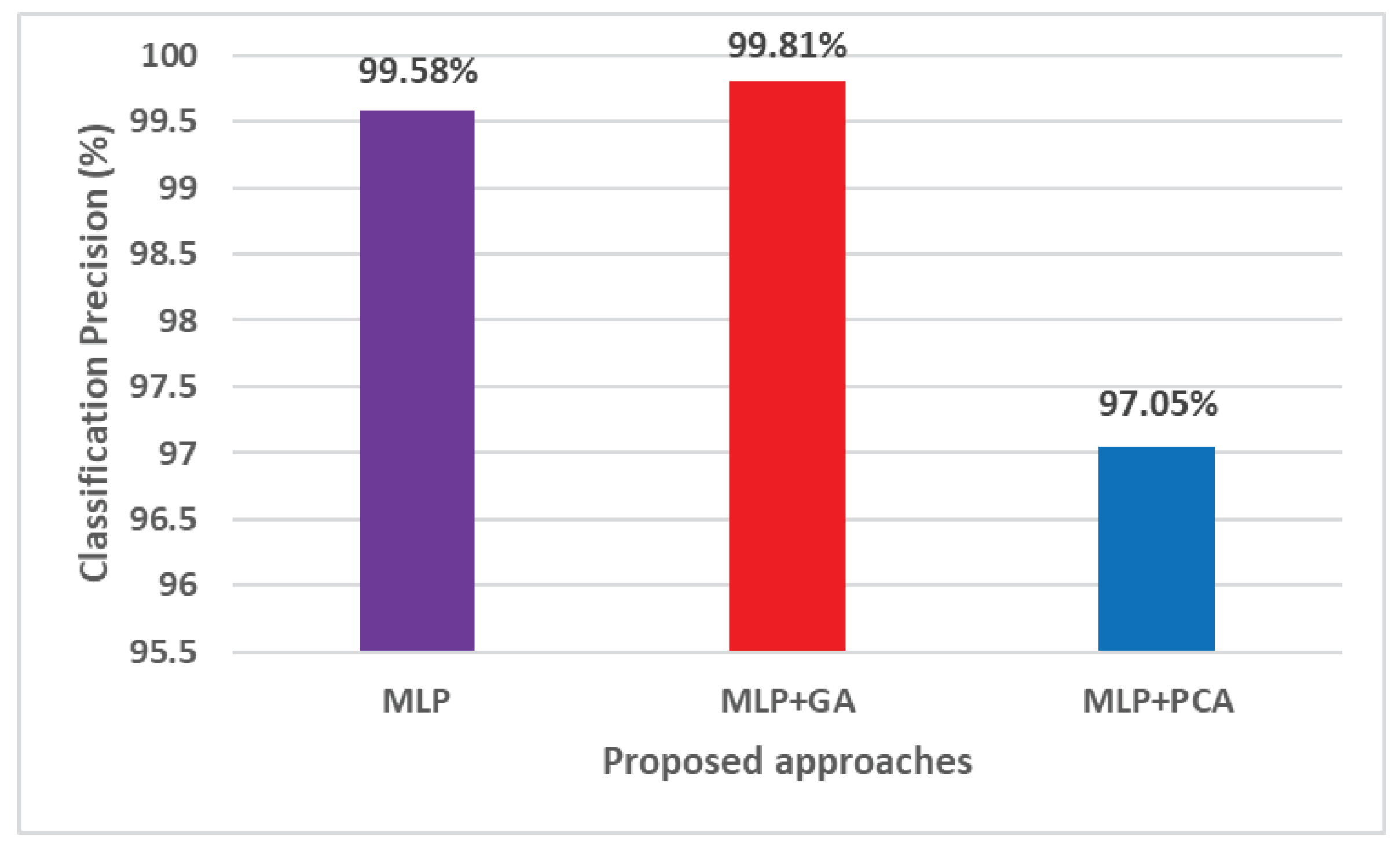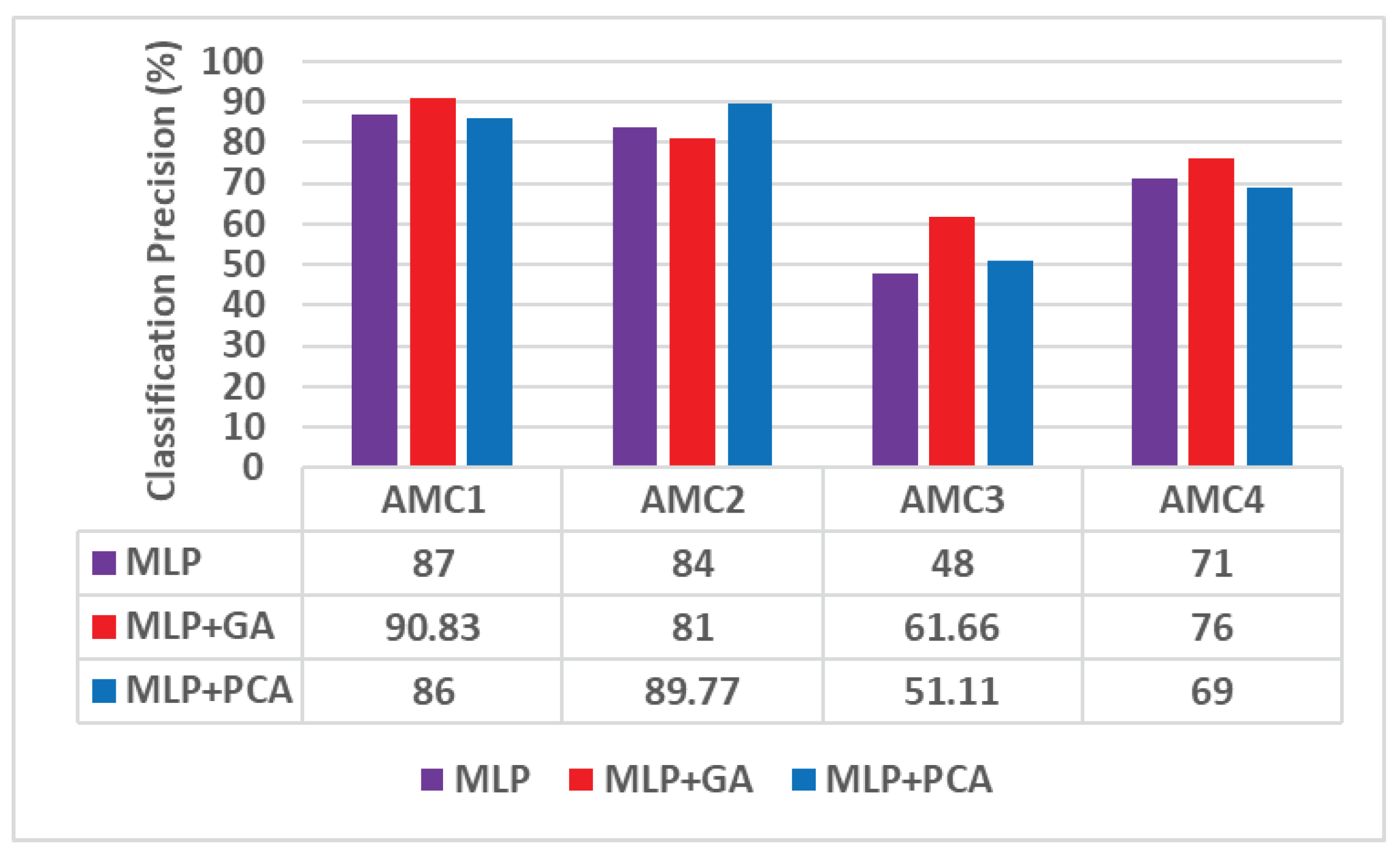1. Introduction
In an optimal radio communication system, the design objective is to allow users to share a medium with minimum or no interference [
1]. RFI is one of the most critical issues facing Satcom since it corrupts radio communication networks, disrupting the transmitter channel and Signal of Interest (SoI) reception capacity [
2]. Nevertheless, a critical capability is concerning robust RFI recognition and characterization through effective real-time monitoring [
3]. Since civilian non-intentional RFI could compromise industry revenues and military interference may cause mission failure and put lives in danger [
4]. In this context, it is essential to deploy effective jamming detection methods in both civil and military applications. The jamming detection technologies need to be adapted to the kind of RFI such that their efficiencies are maximized [
4,
5,
6]. Designing a highly accurate detection technique, which can deal with different jamming types under severe channel distortions, represents an interesting avenue for research.
Several spectrum sensing techniques, such as Cyclo-Stationary Feature Detection (CFD) [
7], Energy Detection (ED) [
8], and matched filtering-based detection [
9], have been proposed for RFI monitoring in Cognitive Radios (CR) [
10]. Among these techniques, CFD [
7] can recognize the SoI from interference and noise, even in very low SNR contexts, but its implementation is computationally very complex [
11]. On the other hand, ED is straightforward to deploy but is unreliable in cases of in-band interference and very noisy conditions [
11]. As the matched filtering detector is highly dependent on the demodulation of a primary user signal, for its part, it requires a dedicated receiver design, which may not be possible in a practical CR terminal [
12]. More significantly, the techniques above can only determine the presence and not the type of interference.
To address this, Artificial Intelligence (AI)-based methods have been employed and found as a superior to traditional approaches since classification techniques may not only determine the different kinds of RFI but also specify the modulation types efficiently. In most of the related studies, the authors focus on either determining the various types of RFI or the modulation types of SoI without considering the presence of the jamming signal.
In this work, we propose a novel approach based on hierarchical classification design to recognize not only the types of the received signal and Automatic Modulation Classification (AMC). To this end, we have considered modulation recognition under two severe conditions such as channel noise and the existence of various jamming signals. Moreover, we have generated a new real-time RFI dataset in which SoI is a video stream transmitted with four modulation types (QPSK, 8APSK, 16APSK, and 32APSK) in a real-time direct satellite-to-ground communication based on DVB-S2 standards. Furthermore, the studied SoI is combined with one of the three major jamming signal types, namely CWI, MCWI, and CI. Notably, we have studied the effect of these three jamming signals on RFI classification and AMC because they are very simple to be deployed by adversaries.
As feature selection is the previous step to classification in supervised learning, we have developed two feature selection approaches, namely the Genetic Algorithm (GA) and Principal Component Analysis (PCA), to select more informative features for an efficient classification process. GA is an evolutionary algorithm that improves the selection process over time. An advantage of GA over other techniques is that it allows the best solution to emerge from the best of prior solutions [
13]. PCA, as a robust feature selection approach, is considered according to its low noise sensitivity, fewer memory requirements, and high efficiency in the training process [
14]. This technique has been used in a wide range of computer science applications for feature extraction [
15]. PCA projects a dataset from many correlated coordinates onto fewer uncorrelated coordinates called principal components, with information preserved as much as possible [
15].
The rest of the chapter is organized as follows:
Section 2 reviews the previous research in RFI classification and characterization; a methodology is proposed in
Section 3; experimental results are provided in
Section 4, and finally, the paper is concluded in
Section 5.
2. Related Works
The main focus of this study is determining the type of received signal and its modulation in a Satcom scenario based on a supervised ML-based classification using MLP. ML methods have been used in different research studies for RFI classification and AMC regarding their flexibility in data processing and accuracy in the designed models. As in [
12] an Artificial Neural Network (ANN) is proposed for a jammer detection in wideband radios. To this end, spectral correlation is used as the feature extraction technique. According to the obtained results, the proposed technique performed efficiently on SNR values down to
dB.
In [
16], three robust ML-based classifiers such as MLP, Support Vector Machine (SVM) and Random Forest (RF) have been deployed to detect jamming attacks in the 5G wireless network. According to the results RF has slightly more precise classification performance. Reference [
17] presents an efficient MLP-based approach to recognize one of the jamming attacks known as Denial of Service (Dos). Moreover, an unsupervised correlation-based feature selection method using the Pearson Correlation Coefficient (PCC) is used to select more informative features. The authors in [
18], present a robust MLP technique combined with a GA-based feature selection to detect various intrusions such as Remote to Local (R2L), User to Root (U2R) and DoS attacks. In [
19], an efficient MLP design has been developed to recognize different intrusions. In [
20], an efficient MLP is proposed to determine either a DoS attack exists in the wireless network or not.
In our previous work [
21], we developed an MLP in different learning modes, namely Stochastic Gradient Descent (SGD), full-batch, and mini-batch. As the results show, the proposed technique can precisely classify four received signals, including SoI and a combination of SoI with three other jamming signals. Moreover, we deployed PCA to select more appropriate features to optimize the classification process.
In this work, we intend to propose a solution to determine not only the type of received signal but also Automatic modulation classification (AMC). AMC is a significant procedure for present and next-generation communication networks and facilitates the demodulation process at the receiver side [
22]. Therefore, modulation recognition is an intermediate step between signal detection and demodulation. AMC is a system that automatically identifies the modulation type of the received signal [
23], and the technology is widely used in various applications, such as dynamic spectrum management [
24] and interference identification in CR [
23].
In [
25], a robust hierarchical classification based on MLP has been presented to recognize the modulation types of communication signals. As was thoroughly discussed in [
14], AMC can be implemented regarding either a likelihood-based or a feature-based scenario. The disadvantages of a likelihood-based approach may include high computational complexity and sensitivity to impairments, such as phase and frequency offsets. The feature-based AMC, maybe comparatively more efficient [
23] as it leverages robust extracted features such as an instantaneous amplitude, phase, and frequency [
26], cyclostationary features [
27], higher-order cumulants [
28], and spectral correlation features [
22]. In [
23,
29], the authors investigated different modulation types of recognition in a digital video broadcasting scenario based on higher-order cumulants and MLP.
AMC-based higher-order cumulant features are the primary concern of this study, inspired by [
23] with proposing an approach based on higher-order cumulants of wavelet coefficients and MLP. Moreover, this study also applies PCA to select features that are more informative to accelerate the classification process. The results indicate that this method precisely classifies various modulation types with an accuracy above
at different SNRs ranges (
) dB [
23]. In [
30], an AMC-based DT approach and higher-order cumulants are proposed. Additionally, different designs of DT, such as Fine Tree (FT), Medium Tree (MT), and Coarse Tree (CT), are also thoroughly analyzed. In [
31], the author has applied SVM as the classifier and 4th-order cyclic cumulant feature to classify three modulation types such as ASK, BPSK, and QPSK by assuming that the channel noise is in the range of
dB. The experiment result shows that the 4th-order cyclic cumulant feature has an efficient discrimination capability in both non-noisy and noisy channels [
31].
4. Results and Discussion
This section presents and analyses the performance of the proposed algorithms for both RFI and modulation classification. All the simulations have been performed with MATLAB (Version R2019b), in a Core i5-5257U CPU computer system, operating at
GHz with
GB. Moreover, the dataset used for the classification has been generated at AWGN power
dBm, and approximately SNR value is 9 dB. As shown in
Table 2, the power of the received signals (dBm/Hz) is measured using a signal analyzer in a
MHz Bandwidth (
).
The Jamming to Signal Ratio (JSR) is computed as
Therefore, the measured JSR for CWI, MCWI, and CI is 7 dB, 5 dB, and 8 dB, respectively.
4.1. RFI Classification Results
The performance of the developed MLP approach in [
21] is considered for RFI classification. Therefore, a two-layer MLP is used with 10 and 4 neurons in the input and output layers, respectively. Moreover, the logarithmic sigmoid and linear functions are used as the hidden and output layer activation functions [
21].
Table 3 presents the details of the designed MLP using different Hidden Layer Neurons (HLN) and Batch Sizes (BS). The training process of this study is performed by the MLP using a 10-fold cross-validation.
As the results show, by increasing the HLN the accuracy can slightly improve. Moreover, due to high variety of classes in the dataset the online learning mode performs better in which the network’s key parameters are updated based on each sample one by one. Therefore, the most accurate result has been achieved using
and online learning mode (BS = 1), with a precision of
.
Table 4 illustrates the results of applying the proposed MLP + GA approach for RFI classification, using the different Numbers of Features (NoF) with
. According to the results, the highest accuracy,
, is obtained with
and
. Also, the classification precision is increased by dealing with more features.
Table 5 demonstrates the result of deploying PCA + MLP for the first classification phase using a various number of features and learning modes such as online learning (
), mini-batch, and Full-Batch. As can be seen, the classification accuracy reached to
with only five features.
Table 5 demonstrates the result of deploying MLP + PCA for the first classification phase. As can be seen, a precise classification was achieved with only five features.
4.2. AMC Phase Results
Table 6 illustrates the MLP-based classification results for modulation type recognition. The number of neurons for each layer is 3, 30, and 4, respectively. The results show that in case of no jamming, the average AMC accuracy is
. In the presence of jamming signals, the classification performance is degraded locally, about
,
, and
for CWI, CI, and MCWI, respectively. Each AMC classifier refers to a specific class of the received signal. AMC1, AMC2, AMC3, and AMC4, are respectively referred to SoI, SoI + CWI, SoI + MCWI, and SoI + CI.
Table 7 demonstrates the effect of GA-based feature selection on the second phase of classification to recognize the modulation types. As is shown, MLP + GA can precisely classify the four modulation types per each received signals using only one feature with a precision of
,
,
and
for AMC1 to AMC4 respectively.
Table 8 illustrates the effect of PCA-based feature selection on classifying the modulation types. As is shown, MLP + PCA performs efficiently using only one feature for AMC1 to 4 with an accuracy of
,
,
, and
, respectively. The learning process is accelerated using PCA because the classifier is trained with fewer features.
4.3. Comparative Classification Results
This section includes a summary of the results for RFI classification and characterization.
Figure 5 demonstrates the comparative analysis of deploying the proposed approaches for the first level classification to recognize the type of received signals. All the three approaches reach performance accuracy more than
, while MLP + GA with five features slightly outperforms other techniques.
Figure 6 indicates the results of the proposed classifiers for the second classification process to distinguish four modulation types (QPSK, 8APSK, 16APSK and 32APSK). As the results present, in no jamming case, the highest accuracy is achieved using MLP + GA (
) with an accuracy of
. For AMC2, MLP + PCA (
) outperforms other techniques with a precision of 89.77%. In the presence the two other jammers such as MCWI and CI, MLP + GA performs more precisely.
Figure 7 illustrates the computation times of the presented techniques for the RFI classification. To this end, we used the “tic toc” function in MATLAB to calculate the consumed training time. As the results show, GA + MLP is computationally more expensive, and as a result, the computation time is comparatively longer, while MLP + PCA is the most efficient one.
4.4. Prediction Phase Results
In this section, the robustness of the proposed techniques is thoroughly analyzed in detecting unseen data generated at different AWGN power ranging from
to
dBm. The performance of the classifier varies depending on the noise level and the existence of jammers. To detect the type of the received signal, the trained MLP using 10-fold cross-validation has a higher generalization accuracy in detecting unseen data generated at the same noise level as the training data. Therefore, the prediction accuracy degrades by increasing AWGN power.
Table 9 shows the results of evaluating the trained classifier’s performance to recognize the type of received signal at different AWGN powers.
Table 10,
Table 11,
Table 12 and
Table 13 show the effect of noise on the trained classifiers in predicting the type of new data. As is shown, two main factors concerning the prediction accuracy are the type of jammer and noise power. Apparently, in the presence of MCWI and CI, the classifiers cannot perform precisely.
5. Conclusions
In this study, a novel hierarchical classifier has been proposed to facilitate the RFI classification and characterization. The proposed classifier not only classifies the type of the received signal but also determines its modulation precisely. Moreover, three robust approaches have been developed, namely MLP + 10-fold cross-validation, MLP + GA, and MLP + PCA. The results confirm that for the RFI classification phase, the classification accuracy reaches 99.81% using the MLP + GA technique, depending on the chosen batch size. In general, MLP + GA performs more precisely in determining the modulation type and RFI classification. Moreover, the results approve that PCA-based feature selection is more efficient in terms of computation time and computational complexity versus GA. In future studies, we intend to look at deep learning-based classification techniques using raw received data to avoid complicated feature extraction and selection steps.












